Themed collection Hybrid Catalysis

Introduction to hybrid catalysis
Motomu Kanai and Matthias Beller introduce the Organic & Biomolecular Chemistry themed issue on hybrid catalysis.

Org. Biomol. Chem., 2021,19, 702-704
https://doi.org/10.1039/D0OB90177F
Integrating abiotic chemical catalysis and enzymatic catalysis in living cells
We review hybrid systems of abiotic catalysis and enzymatic catalysis, which function in living cells. This research direction will stimulate multidisciplinary fields, including complex molecule synthesis, energy production, and life science.
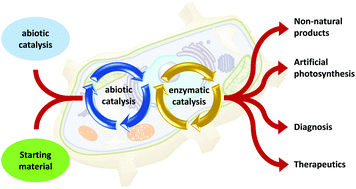
Org. Biomol. Chem., 2021,19, 37-45
https://doi.org/10.1039/D0OB01898H
Probing the versatility of metallo-electro hybrid catalysis: enabling access towards facile C–N bond formation
Metallo-electro catalysis has emerged as sustainable alternate to conventional transition metal methodologies. This review highlights the recent advances for the formation of C–N bonds by merging transition metal catalysis with electrosynthesis.
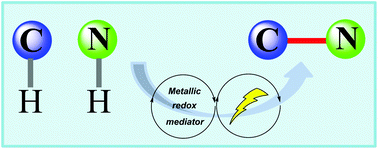
Org. Biomol. Chem., 2020,18, 8994-9017
https://doi.org/10.1039/D0OB01874K
Multiple catalytic sites in MOF-based hybrid catalysts for organic reactions
Catalysts with multiple functions based on/derived from metal–organic frameworks receive growing attention in hybrid catalysis. This review highlights recent advances in organic reactions by MOF-based catalysts with emphasis on multiple catalytic sites and their synergies.
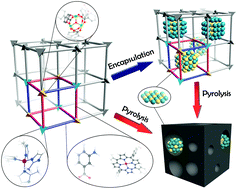
Org. Biomol. Chem., 2020,18, 8508-8525
https://doi.org/10.1039/D0OB01729A
Stereodivergent Pd/Cu catalysis: asymmetric alkylation of racemic symmetrical 1,3-diphenyl allyl acetates
A stereodivergent Pd/Cu catalyst system was developed, which was successfully applied to the asymmetric allylic alkylation of symmetrical 1,3-disubstituted allyl acetates with prochiral imino esters in a fully stereodivergent manner.

Org. Biomol. Chem., 2021,19, 1955-1959
https://doi.org/10.1039/D0OB02499F
Synthesis of substituted anilines via a gold-catalyzed three-component reaction
A three-component reaction for the synthesis of substituted anilines by a gold(I)-catalyzed domino reaction was developed.

Org. Biomol. Chem., 2021,19, 765-769
https://doi.org/10.1039/D0OB02018D
Mannich-type allylic C–H functionalization of enol silyl ethers under photoredox–thiol hybrid catalysis
The synergy of an Ir-based photosensitizer with mild oxidizing ability and a thiol catalyst enables efficient allylic C–H functionalization of enol silyl ethers with imines under visible light irradiation.
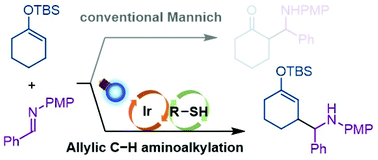
Org. Biomol. Chem., 2021,19, 141-145
https://doi.org/10.1039/D0OB01862G
Nickel phosphide nanoalloy catalyst for the selective deoxygenation of sulfoxides to sulfides under ambient H2 pressure
A titanium-dioxide-supported nickel phosphide nanoalloy (nano-Ni2P/TiO2) functions as a highly active non-precious-metal-based heterogeneous catalyst for the selective deoxygenation of sulfoxides to sulfides under just 1 bar of H2.
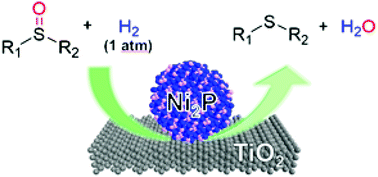
Org. Biomol. Chem., 2020,18, 8827-8833
https://doi.org/10.1039/D0OB01603A
Enantioselective hydrophosphinylation of 1-alkenylphosphine oxides catalyzed by chiral strong Brønsted base
A chiral ureate as a chiral strong Brønsted base catalyst enabled an efficient synthesis of chiral 1,2-diphosphinoalkane derivatives through a catalytic enantioselective hydrophosphinylation of 1-alkenylphosphine oxides.
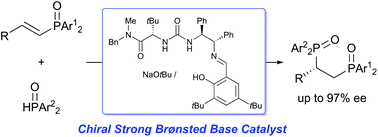
Org. Biomol. Chem., 2020,18, 7814-7817
https://doi.org/10.1039/D0OB01778G
Dealkoxylation of N-alkoxyamides without an external reductant driven by Pd/Al cooperative catalysis
Lewis acid-assisted palladium-catalysed dealkoxylation of N-alkoxyamides has been realised in the absence of an external reductant.

Org. Biomol. Chem., 2020,18, 7545-7548
https://doi.org/10.1039/D0OB01815E
Supported Ni nanoparticles with a phosphine ligand as an efficient heterogeneous non-noble metal catalytic system for regioselective hydrosilylation of alkynes
A convenient and effective heterogeneous non-noble metal catalytic system for regioselective hydrosilylation of alkynes was successfully developed by the combination of Ni/Al2O3 with a xantphos ligand.
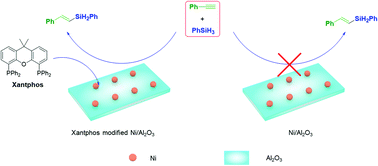
Org. Biomol. Chem., 2020,18, 7554-7558
https://doi.org/10.1039/D0OB01693D
FLP-catalysis meets hydrogen-bond activation
The potential of two chiral amidines and three non-chiral boranes in the metal-free hydrogen activation was explored.

Org. Biomol. Chem., 2020,18, 7321-7325
https://doi.org/10.1039/D0OB01492C
Sequential Conia-ene-type cyclization and Negishi coupling by cooperative functions of B(C6F5)3, ZnI2, Pd(PPh3)4 and an amine
A hybrid catalyst system for sequential Conia-ene-type cyclization/Negishi coupling for union of alkynyl ketones and aryl iodides has been developed.

Org. Biomol. Chem., 2020,18, 7090-7093
https://doi.org/10.1039/D0OB01678K
Rapid access to 3-indolyl-1-trifluoromethyl-isobenzofurans by hybrid use of Lewis/Brønsted acid catalysts
Expeditious synthesis of 3-indolyl-1-trifluoromethyl-isobenzofurans via [1,4]-hydride shift/cyclization/intermolecular nucleophilic addition reaction sequence.

Org. Biomol. Chem., 2020,18, 6602-6606
https://doi.org/10.1039/D0OB01582B
Boracene-based alkylborate enabled Ni/Ir hybrid catalysis
Boracene-based alkylborate enabled visible light-mediated Ni/Ir metallaphotoredox catalysis.

Org. Biomol. Chem., 2020,18, 6598-6601
https://doi.org/10.1039/D0OB01610A
Bifunctional metal–organic frameworks for the hydrogenation of nitrophenol using methanol as the hydrogen source
This work reports the reduction of 4-nitrophenol to 4-aminophenol using UiO-66(Zr) as a bifunctional photocatalyst and hydrogenation catalyst using methanol as the hydrogen source.
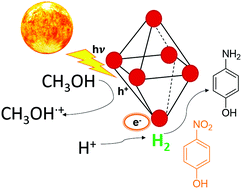
Org. Biomol. Chem., 2021,19, 794-800
https://doi.org/10.1039/D0OB01686A
Anion–cation synergistic metal-free catalytic oxidative homocoupling of benzylamines by triazolium iodide salts
Triazolium iodides are excellent catalysts for the oxidative coupling of benzylamines due to a synergistic cation/anion effect, with iodide acting as I−/I2 redox manifold and the triazolium cation facilitating the iodine reduction and concomitant substrate oxidation.
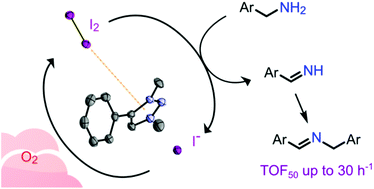
Org. Biomol. Chem., 2020,18, 7379-7387
https://doi.org/10.1039/D0OB01472A
About this collection
The development of novel catalysts plays a central role in advancing organic synthesis. There is a recent, emerging trend in catalysis to merge two or more catalyst components, exhibiting otherwise-impossible reactivity and selectivity. This collection, Guest Edited by Professors Motomu Kanai (University of Tokyo, Japan) and Matthias Beller (University of Rostock, Germany), highlights the exciting research in this ever-growing field referred to as Hybrid Catalysis.
Articles in this themed collection will be added below as soon as possible after they are published.
Please return to this page frequently to see the collection grow.